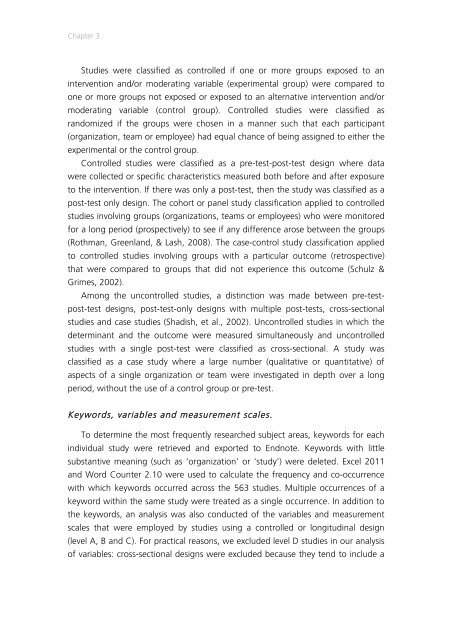In Search of Evidence
jqluvth
jqluvth
Create successful ePaper yourself
Turn your PDF publications into a flip-book with our unique Google optimized e-Paper software.
Chapter 3<br />
Studies were classified as controlled if one or more groups exposed to an<br />
intervention and/or moderating variable (experimental group) were compared to<br />
one or more groups not exposed or exposed to an alternative intervention and/or<br />
moderating variable (control group). Controlled studies were classified as<br />
randomized if the groups were chosen in a manner such that each participant<br />
(organization, team or employee) had equal chance <strong>of</strong> being assigned to either the<br />
experimental or the control group.<br />
Controlled studies were classified as a pre-test-post-test design where data<br />
were collected or specific characteristics measured both before and after exposure<br />
to the intervention. If there was only a post-test, then the study was classified as a<br />
post-test only design. The cohort or panel study classification applied to controlled<br />
studies involving groups (organizations, teams or employees) who were monitored<br />
for a long period (prospectively) to see if any difference arose between the groups<br />
(Rothman, Greenland, & Lash, 2008). The case-control study classification applied<br />
to controlled studies involving groups with a particular outcome (retrospective)<br />
that were compared to groups that did not experience this outcome (Schulz &<br />
Grimes, 2002).<br />
Among the uncontrolled studies, a distinction was made between pre-testpost-test<br />
designs, post-test-only designs with multiple post-tests, cross-sectional<br />
studies and case studies (Shadish, et al., 2002). Uncontrolled studies in which the<br />
determinant and the outcome were measured simultaneously and uncontrolled<br />
studies with a single post-test were classified as cross-sectional. A study was<br />
classified as a case study where a large number (qualitative or quantitative) <strong>of</strong><br />
aspects <strong>of</strong> a single organization or team were investigated in depth over a long<br />
period, without the use <strong>of</strong> a control group or pre-test.<br />
Keywords, variables and measurement scales.<br />
To determine the most frequently researched subject areas, keywords for each<br />
individual study were retrieved and exported to Endnote. Keywords with little<br />
substantive meaning (such as ‘organization’ or ‘study’) were deleted. Excel 2011<br />
and Word Counter 2.10 were used to calculate the frequency and co-occurrence<br />
with which keywords occurred across the 563 studies. Multiple occurrences <strong>of</strong> a<br />
keyword within the same study were treated as a single occurrence. <strong>In</strong> addition to<br />
the keywords, an analysis was also conducted <strong>of</strong> the variables and measurement<br />
scales that were employed by studies using a controlled or longitudinal design<br />
(level A, B and C). For practical reasons, we excluded level D studies in our analysis<br />
<strong>of</strong> variables: cross-sectional designs were excluded because they tend to include a


